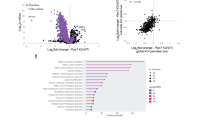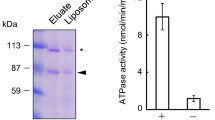Abstract
Peroxisomes are ubiquitous organelles with a single membrane that contain over 50 different enzymes that catalyse various metabolic pathways, including β-oxidation and lipid synthesis1. Peroxisome biogenesis disorders (PBDs), such as Zellweger syndrome and neonatal adrenoleukodystrophy, are fatal genetic diseases that are autosomal recessive2,3. Among the PBDs of the 12 complementation groups (CGs)4, 11 associated PEX genes have been isolated4,5,6,7. Accordingly, only the PBD pathogenic gene for CG8 (also called CG-A) remains unidentified. Here we have isolated human PEX26 encoding a type II peroxisomal membrane protein of relative molecular mass 34,000 (Mr 34K) by using ZP167 cells, a Chinese hamster ovary (CHO) mutant cell line5,8. Expression of PEX26 restores peroxisomal protein import in the fibroblasts of an individual with PBD of CG8. This individual possesses a homozygous, inactivating pathogenic point mutation, Arg98Trp, in Pex26. Pex6 and Pex1 of the AAA ATPase family co-immunoprecipitate with Pex26. Epitope-tagged Pex6 and Pex1 are discernible as puncta in normal CHO-K1 cells, but not in PEX26-defective cells. PEX26 expression in ZP167 cells re-establishes colocalization of Pex6 and Pex1 with Pex26, in a Pex6-dependent manner. Thus, Pex26 recruits Pex6–Pex1 complexes to peroxisomes.
This is a preview of subscription content, access via your institution
Access options
Subscribe to this journal
Receive 12 print issues and online access
$209.00 per year
only $17.42 per issue
Buy this article
- Purchase on Springer Link
- Instant access to full article PDF
Prices may be subject to local taxes which are calculated during checkout



Similar content being viewed by others
Accession codes
References
van den Bosch, H., Schutgens, R.B.H., Wanders, R.J.A. & Tager, J.M. Biochemistry of peroxisomes. Annu. Rev. Biochem. 61, 157–197 (1992).
Shimozawa, N. et al. A human gene responsible for Zellweger syndrome that affects peroxisome assembly. Science 255, 1132–1134 (1992).
Lazarow, P.B. & Moser, H.W. in The Metabolic Basis of Inherited Disease Vol. 7 (eds Scriver, C.R., Beaudet, A.I., Sly, W.S. & Valle, D.) 2287–2324 (McGraw-Hill, New York, 1995).
Matsumoto, N. et al. The peroxin Pex6p gene is impaired in peroxisome biogenesis disorders of complementation group 6. J. Hum. Genet. 46, 273–277 (2001).
Fujiki, Y. Peroxisome biogenesis and peroxisome biogenesis disorders. FEBS Lett. 476, 42–46 (2000).
Ghaedi, K. et al. PEX3 is the causal gene responsible for peroxisome membrane assembly-defective Zellweger syndrome of complementation group G. Am. J. Hum. Genet. 67, 976–981 (2000).
Gould, S.J. & Valle, D. Peroxisome biogenesis disorders: genetics and cell biology. Trends Genet. 16, 340–345 (2000).
Ghaedi, K. et al. Newly identified Chinese hamster ovary cell mutants defective in peroxisome assembly represent complementation group A of human peroxisome biogenesis disorders and one novel group in mammals. Exp. Cell Res. 248, 482–488 (1999).
Wiebel, F.F. & Kunau, W.-H. The Pas2 protein essential for peroxisome biogenesis is related to ubiquitin-conjugating enzymes. Nature 359, 73–76 (1992).
Eitzen, G.A. et al. The Yarrowia lipolytica gene PAY2 encodes a 42-kDa peroxisomal integral membrane protein essential for matrix protein import and peroxisome enlargement but not for peroxisome membrane proliferation. J. Biol. Chem. 270, 1429–1436 (1995).
Elgersma, Y. et al. Overexpression of Pex15p, a phosphorylated peroxisomal integral membrane protein required for peroxisome assembly in S. cerevisiae, causes proliferation of the endoplasmic reticulum membrane. EMBO J. 16, 7326–7341 (1997).
Huhse, B. et al. Pex17p of Saccharomyces cerevisiae is a novel peroxin and component of the peroxisomal protein translocation machinery. J. Cell Biol. 140, 49–60 (1998).
Koller, A. et al. Pex22p of Pichia pastoris, essential for peroxisomal matrix protein import, anchors the ubiquitin-conjugating enzyme, Pex4p, on the peroxisomal membrane. J. Cell Biol. 146, 99–112 (1999).
Tsukamoto, T., Yokota, S. & Fujiki, Y. Isolation and characterization of Chinese hamster ovary cell mutants defective in assembly of peroxisomes. J. Cell Biol. 110, 651–660 (1990).
Morand, O.H., Allen, L.-A.H., Zoeller, R.A. & Raetz, C.R.H. A rapid selection for animal cell mutants with defective peroxisomes. Biochim. Biophys. Acta 1034, 132–141 (1990).
Tamura, S. et al. Human PEX1 cloned by functional complementation on a CHO cell mutant is responsible for peroxisome-deficient Zellweger syndrome of complementation group I. Proc. Natl Acad. Sci. USA 95, 4350–4355 (1998).
Honsho, M. et al. Mutation in PEX16 is causal in the peroxisome-deficient Zellweger syndrome of complementation group D. Am. J. Hum. Genet. 63, 1622–1630 (1998).
Tsukamoto, T., Miura, S. & Fujiki, Y. Restoration by a 35K membrane protein of peroxisome assembly in a peroxisome-deficient mammalian cell mutant. Nature 350, 77–81 (1991).
Shimizu, N. et al. The peroxin Pex14p: cDNA cloning by functional complementation on a Chinese hamster ovary cell mutant, characterization, and functional analysis. J. Biol. Chem. 274, 12593–12604 (1999).
Fujiki, Y., Hubbard, A.L., Fowler, S. & Lazarow, P.B. Isolation of intracellular membranes by means of sodium carbonate treatment: application to endoplasmic reticulum. J. Cell Biol. 93, 97–102 (1982).
Okumoto, K. & Fujiki, Y. PEX12 encodes an integral membrane protein of peroxisomes. Nature Genet. 17, 265–266 (1997).
Okumoto, K. et al. PEX12, the pathogenic gene of group III Zellweger syndrome: cDNA cloning by functional complementation on a CHO cell mutant, patient analysis, and characterization of Pex12p. Mol. Cell. Biol. 18, 4324–4336 (1998).
Tamura, S. et al. Phenotype-genotype relationships in peroxisome biogenesis disorders of PEX1-defective complementation group 1 are defined by Pex1p-Pex6p interaction. Biochem. J. 357, 417–426 (2001).
Tamura, S. et al. A cytoplasmic AAA family peroxin, Pex1p, interacts with Pex6p. Biochem. Biophys. Res. Commun. 245, 883–886 (1998).
Geisbrecht, B.V., Collins, C.S., Reuber, B.E. & Gould, S.J. Disruption of a PEX1-PEX6 interaction is the most common cause of the neurologic disorders Zellweger syndrome, neonatal adrenoleukodystrophy, and infantile Refsum disease. Proc. Natl Acad. Sci. USA 95, 8630–8635 (1998).
Faber, K.N., Heyman, J.H. & Subramani, S. Two AAA family peroxins, PpPex1p and PpPex6p, interact with each other in an ATP-dependent manner and are associated with different subcellular membranous structures distinct from peroxisomes. Mol. Cell. Biol. 18, 936–943 (1998).
Subramani, S., Koller, A. & Snyder, W.B. Import of peroxisomal matrix and membrane proteins. Annu. Rev. Biochem. 69, 399–418 (2000).
Purdue, P.E. & Lazarow, P.B. Peroxisome biogenesis. Anuu. Rev. Cell. Dev. Biol. 17, 701–752 (2001).
Collins, C.S., Kalish, J.K., Morrell, J.C., McCaffery, J.M. & Gould, S.J. The peroxisome biogenesis factors Pex4p, Pex22p, Pex1p, and Pex6p act in the terminal steps of peroxisomal matrix protein import. Mol. Cell. Biol. 20, 7516–7526 (2000).
Hashiguchi, N. et al. Peroxisomes are formed from complex membrane structures in PEX6-deficient CHO cells upon genetic complementation. Mol. Biol. Cell 13, 711–722 (2002).
Otera, H. et al. The mammalian peroxin Pex5pL, the longer isoform of mobile PTS1-transporter, translocates Pex7p–PTS2 protein complex into peroxisomes via its initial docking site Pex14p. J. Biol. Chem. 275, 21703–21714 (2000).
Otera, H. et al. Peroxisomal targeting signal receptor Pex5p interacts with cargoes and import machinery components in a spatiotemporally differentiated manner: conserved Pex5p WXXXF/Y motifs are critical for matrix protein import. Mol. Cell. Biol. 22, 1639–1655 (2002).
Dodt, G. & Gould, S.J. Multiple PEX genes are required for proper subcellular distribution and stability of Pex5p, the PTS1 receptor: evidence that PTS1 protein import is mediated by a cycling receptor. J. Cell Biol. 135, 1763–1774 (1996).
Dammai, V. & Subramani, S. The human peroxisomal targeting signal receptor, Pex5p, is translocated into the peroxisomal matrix and recycled to the cytosol. Cell 105, 187–196 (2001).
Tsukamoto, T. et al. Peroxisome assembly factor-2, a putative ATPase cloned by functional complementation on a peroxisome-deficient mammalian cell mutant. Nature Genet. 11, 395–401 (1995).
Rothman, J.E. & Wieland, F.T. Protein sorting by transport vesicles. Science 272, 227–234 (1996).
Rizo, J. & Sudhof, T.C. SNAREs and Munc18 in synaptic vesicle fusion. Nat. Rev. Neurosci. 3, 641–653 (2002).
Okumoto, K., Abe, I. & Fujiki, Y. Molecular anatomy of the peroxin Pex12p: RING finger domain is essential for the Pex12p function and interacts with the peroxisome targeting signal type 1-receptor Pex5p and a RING peroxin, Pex10p. J. Biol. Chem. 275, 25700–25710 (2000).
Mukai, S., Ghaedi, K. & Fujiki, Y. Intracellular localization, function, and dysfunction of the peroxisome-targeting signal type 2 receptor, Pex7p, in mammalian cells. J. Biol. Chem. 277, 9548–9561 (2002).
Acknowledgements
We thank M. Obo and S. Furuki for technical assistance; R. Tanaka for preparing figures; members of the Fujiki laboratory for discussion; N. Thomas and A. Moser for comments; A. Kawai, T. Kumashiro, and K. Ghaedi for participating in the initial stage of this work. This work was supported in part by a SORST grant from the Science and Technology Corporation of Japan; Grants-in-Aid for Scientific Research and Grant of National Project on Protein Structural and Functional Analyses (to Y.F.); and by The 21st Century COE Program from the Ministry of Education, Culture, Sports, Science and Technology of Japan, a grant from the Uehara Memorial Foundation, a grant from the Japan Foundation for Applied Enzymology, and a grant (to S.T.) from the Naito Foundation.
Author information
Authors and Affiliations
Corresponding author
Ethics declarations
Competing interests
The authors declare no competing financial interests.
Rights and permissions
About this article
Cite this article
Matsumoto, N., Tamura, S. & Fujiki, Y. The pathogenic peroxin Pex26p recruits the Pex1p–Pex6p AAA ATPase complexes to peroxisomes. Nat Cell Biol 5, 454–460 (2003). https://doi.org/10.1038/ncb982
Received:
Revised:
Accepted:
Published:
Issue Date:
DOI: https://doi.org/10.1038/ncb982
This article is cited by
-
Quantitative subcellular reconstruction reveals a lipid mediated inter-organelle biogenesis network
Nature Cell Biology (2024)
-
Current Advances in Protein Import into Peroxisomes
The Protein Journal (2019)
-
The peroxisomal AAA-ATPase Pex1/Pex6 unfolds substrates by processive threading
Nature Communications (2018)
-
Chemically monoubiquitinated PEX5 binds to the components of the peroxisomal docking and export machinery
Scientific Reports (2018)
-
Essential Role of the a3 Isoform of V-ATPase in Secretory Lysosome Trafficking via Rab7 Recruitment
Scientific Reports (2018)



